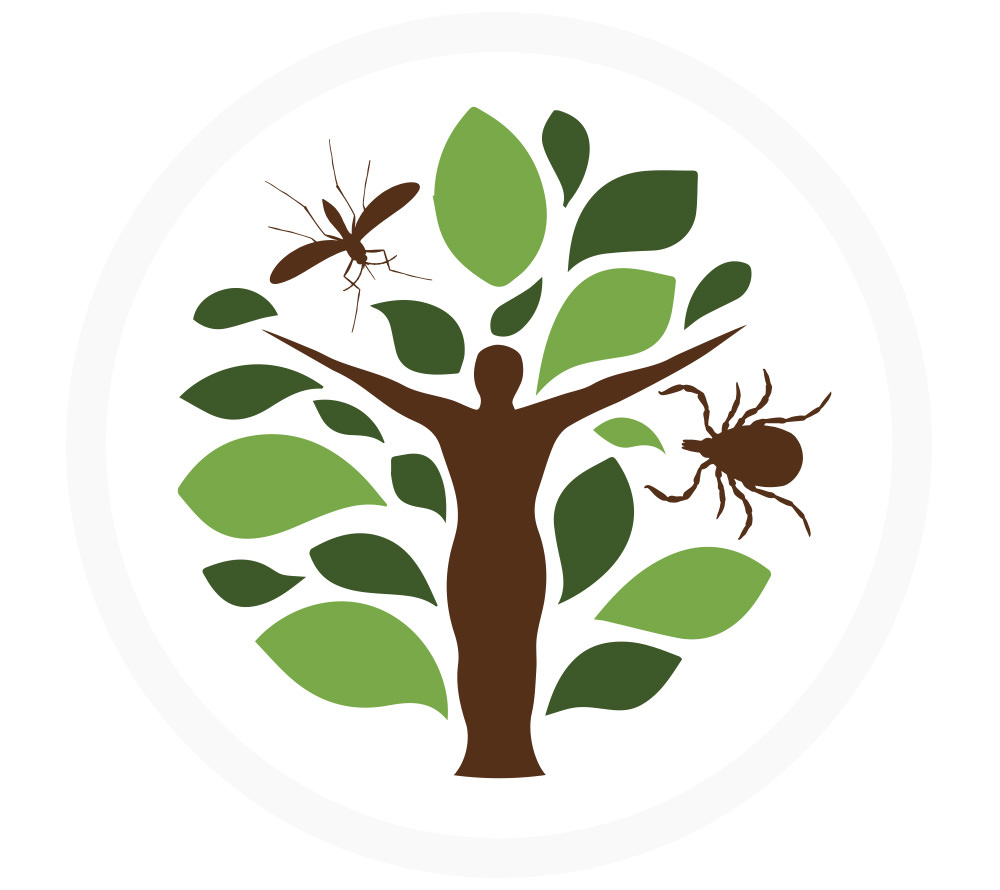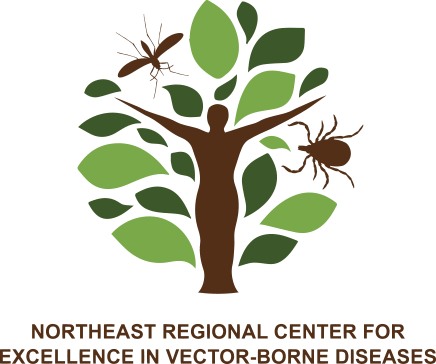Research Focus Area 2: Predicting Human Risk of Exposure to Infected Vectors
Researchers working in this area are combining extensive surveillance datasets and newly gathered information to develop descriptive and predictive models for the presence, abundance, and potential spread of tick and mosquito vectors and their associated pathogens in the Northeast. Accurate information on the current and predicted spatial patterns of human risk of exposure to infected ticks and mosquitoes is essential for the public to make personal protection decisions and for the efficient allocation of public health resources.
PROJECT AREA: Modeling habitat suitability for Ae. albopictus and the effects of climate change on human risk of infection with Aedes-borne pathogens
Climate change models of arthropod-borne infectious diseases tend to be global, often based on sparse data for vector and pathogen species involved in transmission to humans. Yet, recent data point to the importance of studying the impact of climate change on a regional or local scale. Our geographic location at the northern edge of the distribution of Ae. albopictus provides a unique opportunity to determine key factors linked to the completion of the mosquito life cycle and its ability to transmit emerging arboviruses. Using data from our enhanced mosquito surveillance and extensive biological data collected as part of ongoing NEVBD efforts, we will develop models to: (1) determine habitat suitability and human exposure risk to Ae. albopictus and (2) assess potential risk of arbovirus epidemics in the Northeast region. Our goal is to identify risk for human exposure to guide surveillance and control efforts for this invasive species in our region.
We are working with several county mosquito control districts and health departments on this project, including: Nassau County Department of Health, New York City Department of Health and Mental Hygiene, Rockland County Health Department, Suffolk County Department of Health Services, Westchester County Health Department, and others.
Lead Institutions: Columbia University, Connecticut Agricultural Experiment Station
Project Investigators:
- Philip Armstrong, ScD, Connecticut Agricultural Experiment Station
- Maria Diuk-Wasser, PhD, Columbia University
- Gillian Eastwood, PhD, Virginia Tech
- Pallavi Kache, MPH, Columbia University
- Angel Muñoz, PhD, Columbia University, International Research Institute for Climate and Society, The Earth Institute
Project-Related Publications: Muñoz AG, A, Chourio X, Riviere-Cinnamond A, Diuk-Wasser MA, Kache P, Mordecai E, Harrington LC, Thomson MC. 2020. AeDES: A next-generation monitoring and forecasting system for environmental suitability for Aedes-borne disease transmission. Sci Rep, 10, 12640. doi:10.1038/s41598-020-69625-4
Additional Resources:
The Aedes-borne diseases’ environmental suitability (AeDES) maproom allows decision makers to monitor and forecast diseases (including Zika, dengue, and chikungunya) transmitted by the Aedes albopictus and Aedes aegypti mosquitoes to better prepare their communities for future outbreaks.
This maproom incorporates four different environmental suitability models, considering climate factors and mosquito life cycle for North America, Central America, the Caribbean, and northern South America since January 1948. By selecting a point on the map, you can view region specific climate information that includes average monthly values for environmental suitability, precipitation, temperature (minimum, median, and maximum), and number of wet days.
PROJECT AREA: Effects of climate change on the spread and incidence of West Nile virus
Project Overview: Our long-range goal is to study the fundamental relationships between climate – specifically temperature, humidity and rainfall - and vector-borne pathogen transmission at multiple geographic scales. In light of anticipated future trends in temperature and rainfall in the Northeast, we propose to work with an ensemble of climate change model scenarios to estimate and identify (a) the mean (median) outcome, (b) best-case scenarios, and (c) worst case scenarios with regards to the spread of WNV infection rates. Given uncertainties in future projections, we will identify specific timeframes for policy makers to reorient response initiatives based on best available climate science.
Lead Institutions: New York State Department of Health, University at Albany SUNY
Project Investigators:
- Philip Armstrong, ScD, Connecticut Agricultural Experiment Station
- Bryon Backenson, MS, New York State Department of Health
- Alexander Ciota, PhD, Wadsworth Center Arbovirus Laboratory, New York State Department of Health
- Oliver Elison Timm, PhD, SUNY Albany
- Alexander ‘Sasha’ Keyel, PhD, SUNY Albany
- Laura Kramer, PhD, Wadsworth Center Arbovirus Laboratory, New York State Department of Health
- Kathleen McDonough, PhD, SUNY Albany
Project-Related Publications:
- Keyel AC, Elison Timm O, Backenson PB, Prussing C, Quinones S, McDonough KA, Vuille M, Conn JE, Armstrong PM, Andreadis TG, Kramer LD. 2019. Seasonal temperatures and hydrological conditions improve the prediction of West Nile virus infection rates in Culex mosquitoes and human case counts in New York and Connecticut. PLoS ONE 14(6):e0217854. doi:10.1371/journal.pone.0217854
PROJECT AREA: Predicting the geographic spread of multiple tick-borne diseases in the Northeast & the US
Project Overview: The current spatial pattern of risk from tick-borne diseases in the US is dynamic due in part to range expansion of northern populations of I. scapularis that spread Lyme disease and other zoonoses (including human anaplasmosis, babesiosis, ehrlichiosis, hard tick relapsing fever, and Powassan encephalitis). The spatial expansion of the tick vector is central to pathogen and human disease spread. Thus, studying the spatial distribution, dispersal modes and direction, and rates of migration of I. scapularis across space is imperative to strengthen predictions of the arrival and future spread of tick-borne pathogens and provide opportunities for early intervention. Work within this project area will include the development of, mechanistic models for the expansion and prevalence of multiple, interacting pathogens; optimal control models to guide single and integrated vector control interventions; and evaluation of the influence of weather on tick host-seeking behavior and the probability of host attachment.
Lead Institutions: Columbia University, Connecticut Agricultural Experiment Station, Cornell University, New York State Department of Health
Project Investigators:
- Bryon Backenson, MS, New York State Department of Health
- Olivia Card, Columbia University
- Maria Diuk-Wasser, PhD, Columbia University
- Laura Dudley-Plimpton, Columbia University
- Maria del Pilar Fernandez, PhD, Columbia University
- Erin Hassett, MS, Cornell University
- Laura Harrington, PhD, Cornell University
- Eliza Little, PhD, Connecticut Agricultural Experiment Station
- Daniel Mathisson, Columbia University
- Goudarz Molaei, PhD, Connecticut Agricultural Experiment Station
- Kirby Stafford III, PhD, Connecticut Agricultural Experiment Station
- Danielle Tufts, PhD, Columbia University
- Meredith VanAcker, Columbia University
Project-Related Publications:
- Bisanzio D, Fernandez MP, Martello E, Reithinger R, Diuk-Wasser MA. 2020. Current and Future Spatiotemporal Patterns of Lyme Disease Reporting in the Northeastern United States. JAMA Network Open 3(3):e200319. doi: 10.1001/jamanetworkopen.2020.0319 jamanetworkopen/fullarticle/2761874
- Little EAH, Anderson JF, Stafford III KC, Eisen L, Eisen RJ, Molaei G. 2019. Predicting spatiotemporal patterns of Lyme disease incidence from passively collected surveillance data for Borrelia burgdorferi sensu lato-infected Ixodes scapularis ticks. Ticks and Tick-borne Diseases 10(5):970-980. https://doi.org/10.1016/j.ttbdis.2019.04.010
- McClure M, Diuk-Wasser MA. 2018. Reconciling the entomological hazard and disease risk in the Lyme disease system. International Journal of Environmental Research and Public Health 15(5):1048. https://doi.org/10.3390/ijerph15051048
- McClure M, Diuk-Wasser MA. 2019. Climate impacts on blacklegged tick host-seeking behavior. International Journal for Parasitology 49(1):37-47. https://doi.org/10.1016/j.ijpara.2018.08.005
- Molaei, G. M., E. A. H. Little, S. C. Williams, and K. C. Stafford III. 2019. Bracing for the worst: Will range expansion of the lone star tick, Amblyomma americanum, alter the tick-borne disease landscape in the northeastern United States? New England Journal of Medicine 381:2189-2192. https://doi.org/10.1056/NEJMp1911661
- VanAcker MC, Little EAH, Molaei G, Bajwa WI, Diuk-Wasser MA. 2019. Enhancement of risk for Lyme disease by landscape connectivity, New York, New York, USA. Emerging Infectious Diseases 25(6):1136-43. https://dx.doi.org/10.3201/eid2506.181741
PROJECT AREA: The TickApp: A smartphone application to understand the behavioral factors of human-tick contacts
Project Overview: Vector-borne diseases occur in the interface between human and ecosystem health, which are both interrelated and simultaneously affected by human activity, changes in land use, and climate. Lyme disease is the most commonly reported vector-borne disease in temperate zones and its prevalence and geographic range continue to increase. The main objective of this study is to assess how human behaviors and practices affect their risk of exposure to Ixodes scapularis, the tick that transmits Lyme disease (and other pathogens), and the risk of acquiring the disease at an individual level. Using a smartphone application, we aim to assess real-time behavior and movement. This study will produce highly precise behavioral data about tick exposure, which will deepen our understanding on what intervention strategies might be most needed and most effective, pertaining to the fight against tick-borne disease. This information will ultimately be integrated in simulation models (agent-based models) to evaluate the feedbacks between human behavior and the dynamics of the enzootic transmission cycle.
Lead Institutions: Columbia University, Midwest Center of Excellence in Vector-Borne Diseases
Project Investigators:
- Maria Diuk-Wasser, PhD, Columbia University
- Maria del Pilar Fernandez, PhD, Columbia University
- Pallavi Kache, MPH, Columbia University
- Partnering researchers from the Midwest Center of Excellence in Vector-Borne Diseases
Project-Related Publications:
- Bron GM, Fernandez MP, Larson SR, Maus A, Gustafson D, Tsao JI, Diuk-Wasser MA, Bartholomay LC, Paskewitz SM. 2020. Context matters: Contrasting behavioral and residential risk factors for Lyme disease between high-incidence states in the Northeastern and Midwestern United States. Ticks and Tick-borne Diseases. 11(6):101515. doi:10.1016/j.ttbdis.2020.101515
- Fernandez MP, Bron GM, Kache PA, Larson S, Maus A, Gustafson Jr D, Tsao JI, Bartholomay LC, Paskewitz SM, Diuk-Wasser MA. 2019. Usability and Feasibility of a Smartphone App to Assess Human Behavioral Factors Associated with Tick Exposure (The TickApp): Quantitative and Qualitative Study. JMIR mHealth uHealth 7(10):e14769. doi: 10.2196/14769

